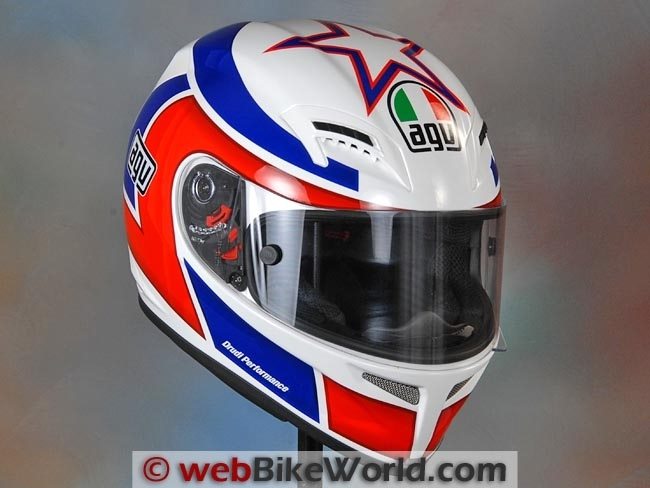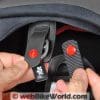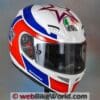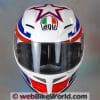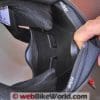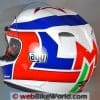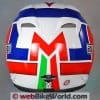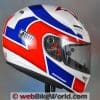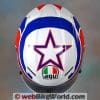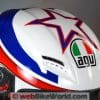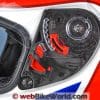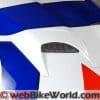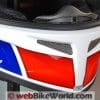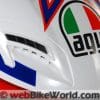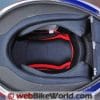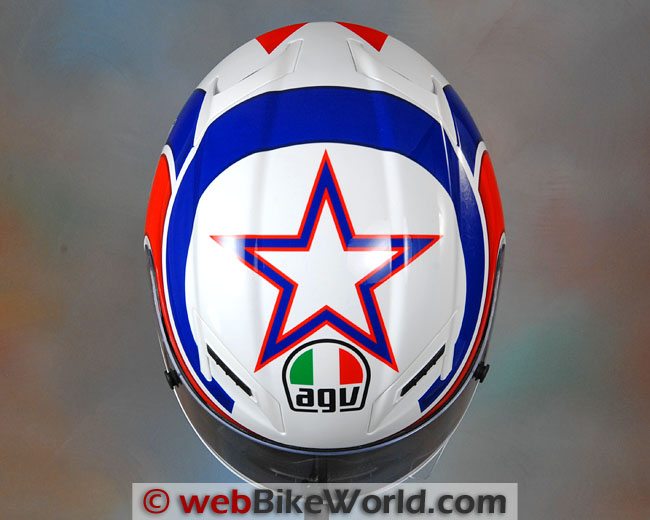The new AGV Grid helmet is an update of the popular AGV T-2 (review). The Grid evolves some of the familiar T-2 features, including that low-profile chin vent with excellent air flow, a “semi-race” fit and excellent overall quality and feel.
The helmet shell is made from a combination of fiberglass, Kevlar and carbon fiber and it comes in three shell sizes. It’s also available in several nice-looking race-replica graphics and other colors.
Had enough adventure-touring gear?
Is it too practical-looking, too functional, too…BMWish?
Then maybe what you need is more style in your life!
And when you combine the words “style” and “motorcycle”, two famous brands come to mind: AGV and Dainese.
The Dainese Air Frame and Aspide textile jackets are just in time for summer and either one is an antidote for the “anything but adventure touring” crowd.
They look great and they have that typical Dainese excellent fit and function.
The Air Frame jacket pairs beautifully with the 2012 AGV K4 EVO helmet, while the new Grid lid works the Aspide jacket in red, white and blue like fashion week in Milan.
Throw ’em on over a pair of the new Dainese D1 Kelvar jeans; slip your feet into the cool (literally) Asphalt boots and top it all off with a pair of matching Dainese Druids gloves for a new summer outfit that’s sure to turn heads!
Next thing you know, you’ll be trading in that BMW GS for a S1000RR!
We’ll start this 2012 AGV and Dainese Summer Style Series with the 2012 AGV “Grid” helmet…
Background
The AGV Grid replaces the popular AGV T-2 (review) for 2012. It slips into the product mix just below the AGV GP-Tech, the company’s top-of-the-line racing helmet.
How the T-2 came to be known as the “Grid” instead of something like T-3 is bit of a mystery.
Perhaps the word “Grid” is more befitting to a semi-race helmet.
Or maybe AGV decided it was time to retire the “T” names since the AGV TiTech (review) is also gone.
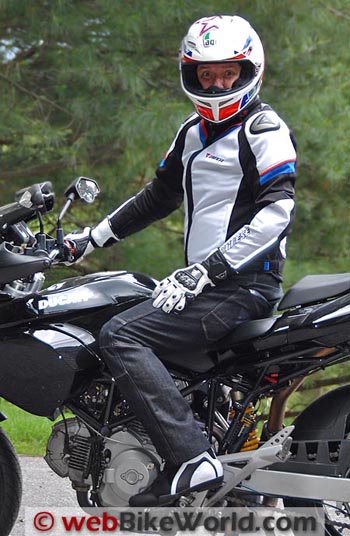
The AGV product literature says it best:
“The Grid has been created to unite the performance (weight, safety, aerodynamics, stability at high speeds) and aggressive lines of a typical racing helmet with the comfort of an on-road helmet, comprising easy fit, ventilation and practical use.
Combining the contents of GP-Tech with less extreme design and new technical solutions, the GRID is the ideal helmet for those who alternate on-road use of their bike with constant track sessions.”
Paint, Graphics and Overall Quality
AGV helmets usually come in a wide variety of colors and graphics and the Grid is no exception.
As one of two helmets in the AGV “Race” category, it’s fitting that the Grid comes in a selection of replica graphics, including the Marco Lucchinelli replica shown here.
Lucchinelli has a rather interesting and colorful background and he was an AGV helmet wearer back in the day.
The star on top of the Grid calls to mind the “Lucky Star”, one of Lucchinelli’s nicknames, as illustrated on his website.
The Grid is also available in solids and graphics and other race replicas, including Giacomo Agostini, Angel Nieto, Barry Sheene and the famous Valentino Rossi “Sun and Moon” design from 1996 (seems like just yesterday!).
The paint and graphics on this one are excellent and the colors are also highly visible, which is a plus.
Perhaps it wasn’t intentional, but this graphic combines a red, white and blue design that is reminiscent of the American flag with the Italian Tricolore red, white and green.
Together, this reflects the great friendship and shared heritage of these two countries.
There are no flaws visible in the paint and graphics on this helmet, nor is there any indication of “orange peel” in the clear coat, which doesn’t feel quite as thick as it does on other helmets, but seems adequate for the task.
The overall build quality, the solid feel of the tri-composite shell and the very nicely designed face shield all speak to AGV quality.
We noted this on the AGV AX-8 Dual EVO (review) and it is apparent also on the updated K4 EVO, which will be reviewed as part of this series.
Score: I’ll give the AGV Grid an “Outstanding” rating for excellent overall quality. See the Summary Table at the bottom of the page for a description of our rating system.
AGV Grid Helmet Fit, Internal Shape and Liner
We don’t have a T-2 available for comparison but looking over the notes from my T-2 review, the Grid has about the same fit and internal shape.
The fit is derived from the AGV GP-Tech race helmet and it’s a bit difficult to describe. It feels neutral to round at the top and definitely not as narrow or “long oval” as the AGV K4 EVO. The Grid helmet shell tapers in slightly towards the bottom, to give a semi-race fit.
I think the Grid fits similar to an Arai RX-Q (review) along the top half of my head; that helmet is a “round oval” shape in the Arai classification.
The Grid is slightly more tapered along the sides from my cheek bones down though.
Since the Grid is near the top of the AGV helmet lineup, it has some features available that you won’t find on less expensive AGV helmets.
This includes accessory helmet liners, and cheek pads in different sizes and thicknesses, both of which can be mixed and matched to get that bespoke fit.
This Grid in size large feels correct in the listed 59-60 cm size and it should fit most rider head shapes in those sizes. 60 cm is probably max though for the size large; anyone with a head size over that should probably go up one size.
The slight inward curvature along the bottom of the helmet shell makes the standard cheek pads at 30 mm thick feel a bit tight for me, so I may buy a set of the reduced thickness cheek pads, which are 25 mm thick — should be perfect!
The fiberglass, Kevlar and carbon fiber helmet shell for the Grid is made in three sizes.
The smaller shell fits the XXS to M sizes; the mid-sized shell fits L and XL and the large shell fits XXL to XXXL. This should eliminate any of that “fish bowl” look that can occur when a smaller head size fits a too-large helmet shell.
The bottom line is that I think I’ll call the Grid as a “Neutral” fit in the webBikeWorld classification scheme. It should fit a wide range of rider head shapes and again, the cheek pads and even helmet liners can be swapped out for a custom fit if desired.
The padding in the Grid has been upgraded from the T-2 and the liner material was specially designed to allow the helmet to slide more easily on or off the head. I think it works and the liner padding and fabric feels comfortable.
It’s removable and the helmet includes a tight-fitting chin curtain. The liner fabric is said to have been designed for moisture wicking and also treated with an anti-bacterial coating.
The ear pockets are of average size and depth and can fit intercom speakers. Also, the shell and liner design along the bottom of the helmet makes for an easy fitment of typical intercom helmet mounts.

More information on helmet fit can be found in the webBikeWorld Motorcycle Helmet FAQ page, along with the chart that lists the helmet weights of webBikeWorld reviewed helmets and also by shape on the webBikeWorld Motorcycle Helmet Shapes page.
Score: I’ll give the AGV Grid an “Outstanding” rating for shape, comfort and padding with a very nice liner and padding that works well in hot weather.
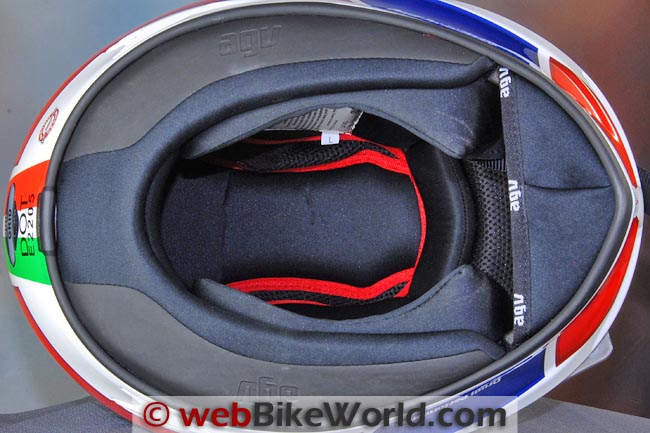
AGV Grid Eye Port and Outward Visibility
The AGV “RACE-X 2011” face shield on the Grid is derived from the GP-Tech and includes an anti-scratch and anti-fog treatment. AGV also claims that it provides 100% protection from UV rays.
We measured the face shield at 2.30 mm thick and it also includes tear-off posts.
The AGV T-2 had a very nice face shield and the Grid improves on that.
It has very firm-feeling and strong detents with 6 opening positions. The first position is good for air flow or defogging, although it’s a slightly larger opening than I prefer, but it works.
The face shield also has a nice, large lift tab on the lower left-hand side.
Use it to snap the shield up or down and when it’s closed, the face shield seals tightly against the full-surround eye port gasket to prevent air or water leaks.
The removal mechanism is a real beauty; it’s easy to use and it has a solid feel. It’s also designed to keep the face shield in place during a crash and AGV has a racing kit available for the Grid, which includes “a perforated visor and safety screws”.
The visibility out of the eye port is only average, however, and this is a bit of a surprise.
The smaller eye port is probably a good thing for racing, but the view out the top of the eye port when the rider is leaned forward on the motorcycle seems slightly more restricted than I’d expect.
The top of the eye port is always in my line of sight. It’s not annoying, just there. So overall I’d say the visibility is average to slightly less than average compared to a pure street helmet but consistent with race helmets.

Score: The AGV Grid visibility is average, so I’ll give it a “Very Good” rating overall.
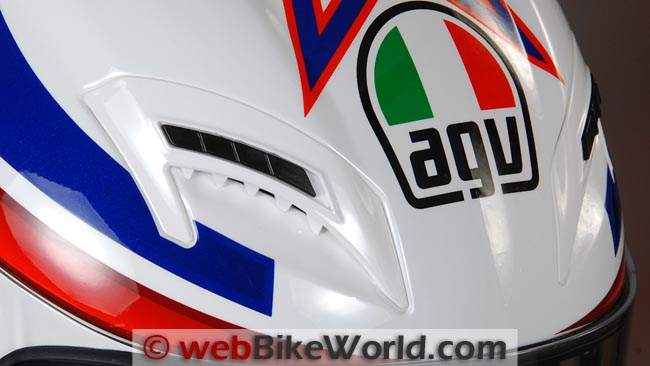
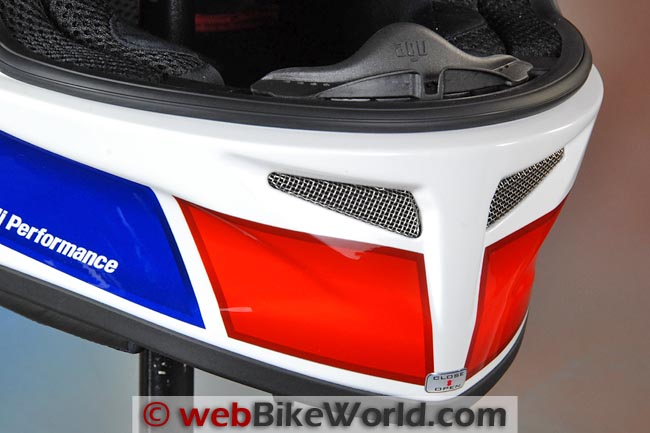
AGV Grid Ventilation and Air Flow
The Grid has what appears to be the same ventilation system that was found on the AGV T-2. The most notable feature is the flush-mounted chin vent, which consists of two screen-covered vent ports, angled upwards.
The chin vent operates via a switch located inside the chin bar, just like the T-2. This means you have to reach up around the chin curtain with your thumb to flip the switch on or off. It’s not as easy as using an external control, but it feels solid and it works.
The chin vent on the Grid, like the T-2 before it, pours a huge amount of air into the helmet through four separate vent channels in the chin bar.
The vent channels have a direct and visible path from outside the helmet into the interior, and this provides some of the best lower air flow found on any helmet.
The top vents open with small sliders that move from side-to-side rather than front-to-back, also just like the T-2. They are slightly more difficult to operate when wearing gloves and the air flow they provide is also reminiscent of the T-2.
It isn’t as dramatic as the chin ventilation, because it’s partially blocked by the liner and the actual top vent openings are very small.
There is a direct passage of air from the top vents through the EPS and into a channel along the top of the liner inside. The liner is mesh along the channels, so the air does flow along the top of the rider’s head.
Also like the T-2, the exhaust and extraction system helps to pull the air out the back. The exhaust ports placed at the back of the raised channels that can be seen molded into the top of the helmet shell.
Overall though, the top vents don’t seem quite as efficient as the chin vent system. The air moves through the top of the helmet but isn’t directly felt as a strong air flow.

Score: I’ll rate the ventilation system of the AGV Grid as “Excellent”.
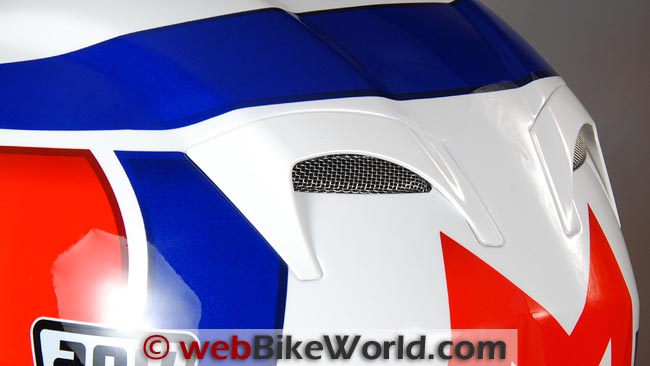
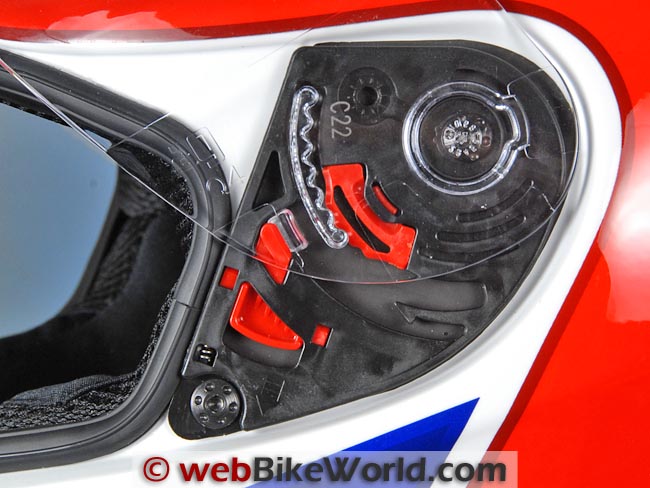
AGV Grid Sound Levels
Overall, the Grid is relatively quiet, due to the inward taper of the shell and the tight fit along the cheeks and lower portion of the liner, which help keep wind noise out. Also, the aerodynamic shape and overall design help flow the air and reduce lift and turbulence, which also helps reduce noise levels.
The top vents can be made to whistle slightly, but only at an intermediate head angle. Sitting up straight, the vents seem quiet and leaned forward in a sportbike tuck, the vents are also quiet.
The tight fit of the face shield and the chin curtain also help reduce noise levels, so overall I can rate the Grid as slightly quieter than average.

Note that our helmet evaluations are a combined effort of several riders over time on different types of motorcycles with and without windscreens.
Evaluators wear correctly fitted, high quality ear plugs (even when evaluating motorcycle intercom systems).
Always protect your hearing when riding a motorcycle. See the wBW Earplug Reviews for more information on choosing and wearing earplugs.
Note also that perceived noise levels will vary, depending on the individual.
Noise can be caused by many factors, including helmet fit, the type of motorcycle and windscreen, wind speed and direction and even the rider’s clothing.
For more information on helmet noise, visit the wBW Motorcycle Helmet Noise page.
Score: I’ll give the AGV Grid an “Excellent” rating for better than average noise control.
Helmet Weight
This Grid in size large weighs 1615 grams (3 lbs., 8-7/8 oz.), which is a respectable showing, putting the helmet slightly below mid-point in the 190 helmets weighed for reviews to date for webBikeWorld.com.
The close-fitting liner and “semi-race” fit help keep a good snug fit and this helps to balance the weight and distribute it evenly along the helmet.
For comparison, some other helmets of this type in size large include the Arai RX-Q (review) in size L at 1597 grams, the Bell RS-1 (L) at 1603 grams and the Roof Boxer V8 (review) at 1609 grams.
Also the Zeus ZS-806 (review) at 1620 grams; the Arai Signet-Q at 1624 grams; the Bell Star 2010 (review) at 1628 grams and the Vemar Storm (review) at 1637 grams.
Note that all of the helmets reviewed on webBikeWorld have been weighed and the weights are available on the wBW Motorcycle Helmet Weights page, along with a chart that lists the helmets by weight and shape on the wBW Motorcycle Helmet Shapes page.
Score: I’ll give the AGV Grid an “Excellent” rating for its relatively low weight and good balance.
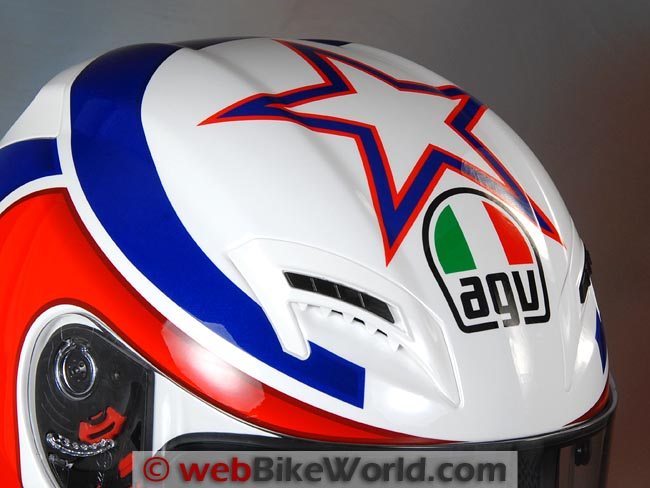
Miscellaneous
The AGV Grid has a double D-ring attachment system for the chin strap. The padding is adequate although not quite as plush as I’d like.
The chin strap retainer is a separate section that contains the snap, and this is a clever design that makes it easy to find and to snap the extra length of chin strap without having to fish around to find the snap.
The Grid meets both DOT and ECE helmet safety standards.
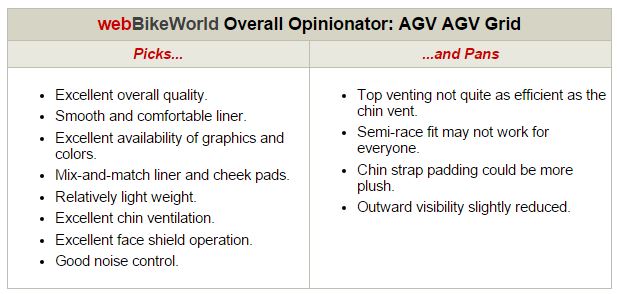
Conclusion
The new AGV Grid is a nice evolution of the original T-2 helmet. It keeps the features that made the T-2 so popular and it brings AGV race technology to the masses at a price that’s 30% less than the full-on GP-Tech helmet.
The Grid is a good blend of sport and race helmet design, although it may be slightly too race biased for touring riders.
If you’re not into sportbiking or track days, AGV has many other helmets that are well suited, including the K4 EVO which will also be reviewed as part of this series.
Overall, I think the Grid is an excellent design that includes many AGV technologies and design ideas developed through their race program.
The tri-composite shell feels exceptionally strong and, when combined with the tight-fitting and solid-feeling face shield and vent controls, gives a feeling of security and quality that is missing from lesser helmets.
The Grid also has plenty of style.
And don’t forget the price, which is reasonable for what you get and a relative bargain when compared to high-end Arai and Shoei helmets or even AGV’s own GP-Tech. Taken altogether, I can highly recommend the AGV Grid for your consideration.
| wBW Review: AGV Grid Helmet | |
|---|---|
| Manufacturer: AGV SpA | List Price (2012): $399.00 (Solids) to $499.00. |
| Colors: Solids, graphics and replicas. | Made In: China |
| Sizes: XXS-3XL Shell Sizes: 3 | Review Date: June 2012 |
|
Rating Scale is subjective: Unacceptable, Poor, Neutral, Very Good, Excellent, Outstanding.
|
|
Note: Item provided by a retailer, distributor or manufacturer with these Terms and Conditions.
Owner Comments and Feedback
See details on submitting comments.


